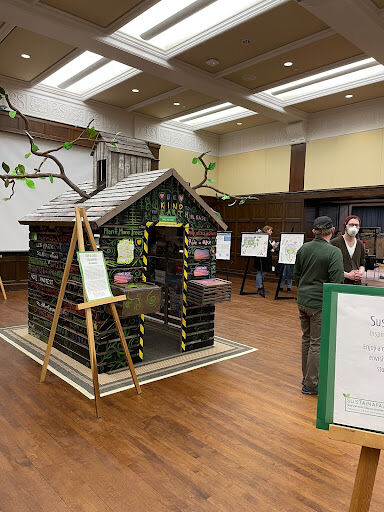Sustaining the future by connecting in the present
February 22, 2022
What’s one thing that can get local artists, thrifting fashionistas, a Co-op and Iowa State University Dining all under one roof? Sustainability.
The annual Sustainapalooza event kicked off at 5 p.m. Tuesday, and the buzz of the event carried well into the 8 p.m. end time. The event included multiple Green It Yourself (GIY) stations, such as building a terrarium, mixing a household cleaner and upcycling a tee-shirt into a plant holder.
Many statement-making local artists were featured, including Rob Sunderman’s “Crib in Crisis Encounter,” an inquisitively painted wood shack with pictures of environmental crises decorating nearly every interior inch.
One could not leave the event without noticing Brittny Rebhuhn’s “Disposed” sculpture. Standing at least six feet tall and built entirely of plastic bags, the street puppet prompts people to ponder how to reuse plastic bags to prevent them from harming the environment.
“Well, it’s really cool to see everything come together,” said Ashlyn Bickett, a junior majoring in genetics and volunteer. “And I am really passionate about sustainability. And so this is an awesome event to kind of raise awareness for that in the community, but then also a super fun opportunity to connect with other people that are also really passionate about sustainability, especially on campus.”
Bickett is one of many Iowa State students to attend Sustainapalooza, but sustainable practices are nothing new to her. Bickett is already dedicated to living a sustainable life through her daily practices.
“Personally, I really like to compost my food,” Bickett said. “And then my main source of clothing is thrifting. Yes, that’s the main thing. I also try to take public transportation as much as I can, just to kind of help with my own personal carbon footprint.”
Sophi Wilker, a member of the student organization, The Green Umbrella, also likes to compost.
“The easiest thing to do is recycle, reduce what you’re using,” Wilker said. “Food waste is a huge thing. So if you have the resources, composting is a very easy [way] to get rid of the amount of waste you’re producing.”
While the idea of going green can be overwhelming, Wilker emphasized the simplicity yet importance of consuming less.
“So whether that’s buying less clothes, buying secondhand, trading things with your friends and borrowing when you need and not buying something super cheap for one event,” Wilker said. “It’s making those kinds of choices to consume less.”
Living a sustainable lifestyle looks different for everyone, and the definition of sustainability is just as fluid.
“Personally, I think of sustainability as something that I want to strive for, to help make a positive impact on my community and the planet,” Wilker said. “So like, making decisions actively that really promote sustainability and living an environmentally friendly lifestyle. So not only promoting that, and educating people around me, but living and making those choices myself.”
For Joey Romo, a member of the student organization Engineers for a Sustainable World, sustainability means something a little different.
“Finding different ways to use less of Earth’s resources [and doing so] in a way that promotes human flourishing over generations,” Romo said. “It means using the least amount of Earth’s natural resources in order to promote quality of life.”
Sustainable practices don’t have to be life-altering changes, but for passionate individuals, student organizations such as Engineers for a Sustainable World offer hands-on sustainability projects.
Engineers for a Sustainable World has projects focusing on reducing plastic waste, composting, stormwater management and solar energy, all on Iowa State’s campus. The organization’s SolarCentric project team has been working on creating a solar-powered water fountain since last fall.
“Currently, we’ve been trying to make the assembly of it all,” Romo said. “Every single Monday, we work for about an hour to two hours cutting up wood and try to make it fit for the components that we bought… whether it’s kind of bending different brackets to make it, or just cutting off different pieces of wood.”
By advancing the community with projects like SolarCentric, Engineers for a Sustainable World is not only inviting new technologies to the community, but also all the derivative aspects of said technologies, such as educational benefits.
Romo said the advances made in new technology since his freshman year are “crazy.”
“Renewables is a growing industry that grows every single day, and I really do mean that,” Romo said. “So right now, you know, you have solar that’s completely, like kind of renewable. And next thing, you know, you have renewable compressed air systems, you have biomass, you have wind turbines, you have all these different things. It kind of goes to the next thing that there’s so many forms of renewable energy, and I know it’s gonna be a lot more in the future, which I’m really excited about.”
While Sustainapalooza is a one-time yearly event, the participants continue working year-round to harness excitement about how the future can change for the better. Engineers for a Sustainable World does outreach work within the Ames community.
“Whenever a campus event has anything to do with sustainability, we are usually your first contact for Merry Rankin, the head of sustainability,” Romo said. “As for schooling and stuff like that, we’ve gotten some contacts in Ames public schools. They’re always trying to get more kids involved in STEM and sustainability becoming a bigger industry. They’re looking for different projects like this.”
For more information about how to get involved in a sustainable future, visit Iowa State’s Sustainability page, here.

















